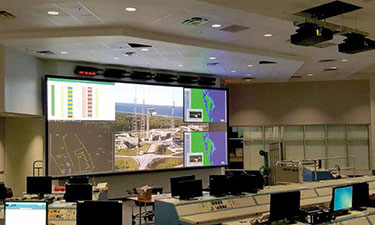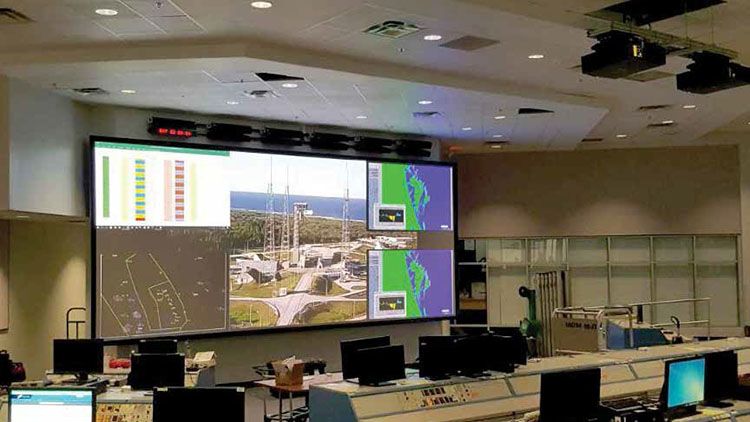As the sun continues to set on the days of analog, AV-over-IP and networked control rooms are becoming increasingly commonplace in the enterprise. While there is still room for improvement in network asset management systems, they currently offer significant benefits, not only to operation center staff, but also to managers looking to improve operational efficiency.

Morrell Operations Center in Cape Canaveral’s Air Force Station.
“Operators in NOCs, SOCs, APOCs, and all the other OCs use networked applications to view situational data, collaborate on incidents, and communicate with peers,” said Bob Ehlers, VP marketing, RGB Spectrum. Network applications generally are getting better at supporting workflow within their frameworks, he also noted, enabling efficiencies by allowing operators to focus on their jobs.
“Application workflows include the identification of exceptions, the routing of tasks from one person to the next, and the escalation of decision making up the command chain based on preset rules,” Ehlers continued. “More often, data, such as video and voice, are augmented with metadata from sensors and advanced analytics allowing for automated parsing and routing of information, eliminating distractions and visual clutter. Artificial intelligence can process possible decision trees based on this data and direct operators to the best possible course of action.”
With visual data ever increasing and moving from the wall to the desk, and out of the room to smartphones, AV-over-IP enables the flexible routing, distribution, and display of visual information that follows network application workflow, Ehlers said. “Video walls reflect operational overview information that needs to be shared with everyone in the room. ‘Walls on the desk’ present a large working canvas on which individual operators can view an ever-increasing amount of data. And then the individual operators need to be able to select portions of their desktop data to share back up to the wall and distribute out over the internet to smart devices of field staff.”
Flexible, intuitive routing and control of video distribution are essential, according to Ehlers. “Operators need to use ‘finger memory’ to select what visual data they need to distribute. Then they need to quickly and easily select distribution groups of destinations for that data to flow to.”
Security has become a major issue—and a source of embarrassment for some companies—and is essential for protecting sensitive data from unauthorized access, as Ehlers further noted.
But with no standardized security policies associated with small, single-purpose, shared devices and appliances, organizations have been uncertain how to deal with them, according to Paul Zielie, manager, enterprise solutions, Harman Professional, CEG. Some have turned a blind eye for years, but recent security breaches have reversed that trend, and now devices are failing security audits—not because anything has changed, but because they were not previously included in the audits.
Zielie observed that not only can networked asset management systems relieve the strain on human operators, but metadata and analytics also enable interesting capabilities in terms of inventory control and management. Because of a unique ID that follows a device, managers can find out what room it’s in, and the history of rooms it has been in, he noted.
The information-gathering capabilities inherent within these systems are also critical to making informed business decisions. The fact that a $100,000 conference room is fully booked may suggest that the organization should build a second one. “But if you have the right kind of data you’ll very likely find that 60 percent of the time there are five or fewer people and they’re using one screen and the telephone,” Zielie said. “You can take 50 percent of the pressure off that room for just $15,000.”
Data analytics also spills over to the helpdesk, he said. Root-cause analysis of help requests might show that a certain interface button is not well understood: “So we’ve got to figure out how to make that button clearer.”
CLOs and operations staff can also use the data streaming off a network to maximize operational efficiency, which is how they get their bonuses, after all, Zielie pointed out. “These numbers are rough, but for a conference room, only about 30 percent of the money they spend is on capital acquisition and integration; 70 percent is on operational costs. What we have as a promise of the network is being able to drive down the total cost of ownership by 30 or 40 percent—without having to drop the cost of my equipment, hopefully,” he laughed.
Driving down support costs is a big issue. A multinational corporation must provide the same level of service to a regional office as it does to its corporate headquarters. “They can’t afford to put a trained person at the office in Iowa to support 50 people; the only way to do it is on the network,” Zielie said. “But we as an industry have not built out all those tools yet, although we are starting to.”
The unrealized power of networks is that they can reveal to operations staff through data analytics where there is a problem or where improvements might be made, reducing repair time, enabling configuration files to be pushed to devices, or highlighting common operator errors. “Frankly, I don’t think 8K video is going to improve anybody’s user experience,” said Zielie. “The places where we can really move the needle is in operational efficiency and using these tools to understand what we need to optimize these systems.”
Steve Harvey (sharvey.prosound@gmail.com) is editor-at-large for Pro Sound News and also contributes to TV Technology, MIX, and other NewBay titles.
